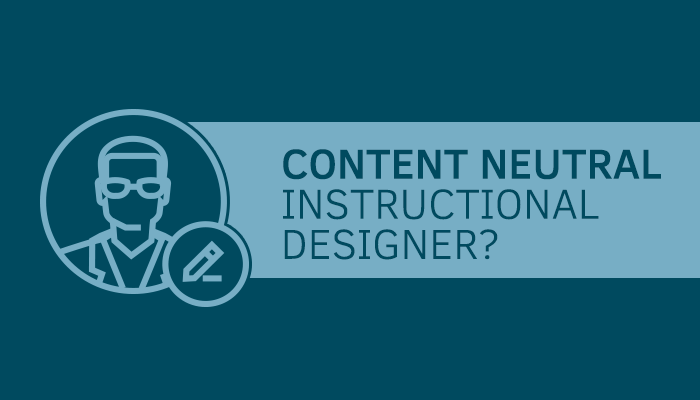Content Neutral: What It Means and Why It Matterscontent neutral instructional designer
Heard the words “content neutral” applied to instructional design but not entirely sure what they mean? Simply put, Content Neutrality means an instructional designer does not specialize in any particular type of content or industry, but rather can work with just about any subject matter expert on any training topic to produce eLearning and other training materials. By focusing and honing their skills on tasks like subject matter expert interview techniques, content analysis and organization, learning objective identification, focus and user group testing, and more, these instructional designers can design and direct the production of training materials with little-to-no prior experience with the content. At eLearning.net, many of our instructional designers are content neutral and many others specialize in specific industries so we approach instructional design from many angles. Following are some additional descriptions of what makes content neutral instructional designers special. content neutral instructional designer
Instructional Design Generalists
While some instructional designers work within the same niche for long periods of time and build their expertise, that is not true for most. In fact, most designers move from industry to industry and niche to niche with each new project. They are not specialists and are able to work with topics unfamiliar to them.
Content Conversion
One of the simplest ways for an instructional designer to become familiar with new material is to simply study existing content such as operating instruction manuals, HR content, or existing course material and convert this content to training using instructional design techniques. Oftentimes existing material can be re-purposed for use in the new course with a some basic reorganization, rewriting, clarification, and streamlining. Even if this material cannot be completely reused, it can still shed light on the topic and help with the creation of new content.
Workplace Skill & Task Analysis
Content neutral instructional designers perform task analysis to identify the specific skills needed within the workplace. Generally, the designer seeks to identify what sorts of skills are needed to complete various tasks within the organization, as well as any sub-tasks. The end result is what is referred to as Skills and Competencies Definitions. For organizations that have a robust Human Resource Information System (HRIS) and integrated Learning Management System (LMS), these skills and competencies can be associated with learners so that courses are automatically assigned to them based on their job roles.
Conducting Thorough Research
There is no substitute for good research. By thoroughly researching a subject, a designer can get a good handle on content even if no existing content is supplied. Professionally written books, trade journals, magazines, blog posts, and online articles can all shed invaluable light on the processes, skills, and topics of importance. However, it’s important that the designer take steps to verify the authority, authenticity, and accuracy of all material they research (particularly when it comes to online information).
Performing Multiple SME Interviews
One of the best ways for a designer to become familiar with specific content is to interview subject matter experts (SMEs), managers, and key employees. By interviewing experts, the designer can drill down to the most important information immediately, but it’s generally best to combine this approach with research, reading, and other methods first. SMEs tend to be very busy, and a designer should lay the strongest foundation possible before the interview.
Analyzing the Instructions
This step is generally done when there is little or no existing content, or the content that does exist is of a dubious nature. The designer will identify the steps needed to reach the goal in question and then create a learning map showing the different skills and knowledge areas required for those steps.
Read More:
What Instructional Designers Need to Know About Gagne’s Nine
